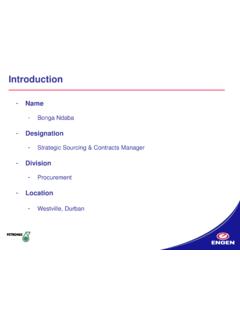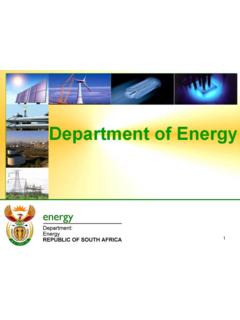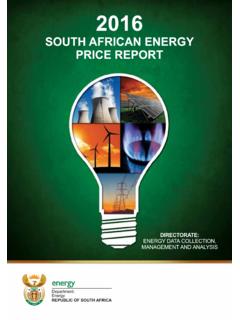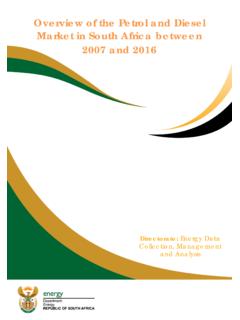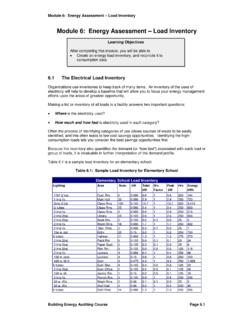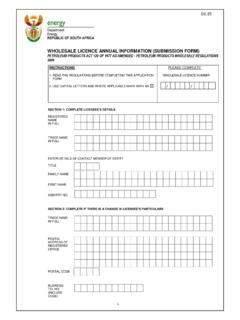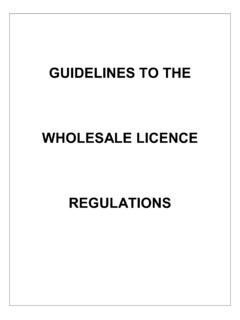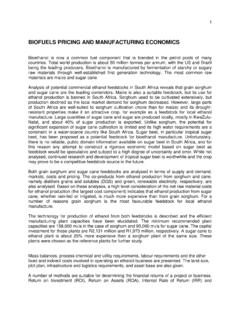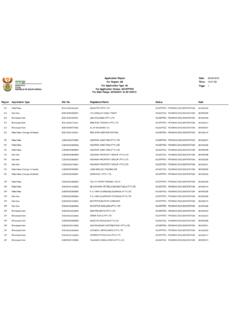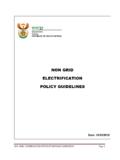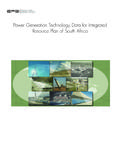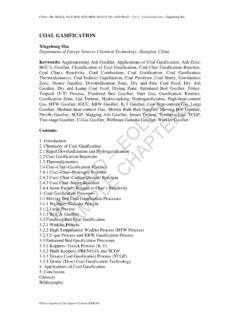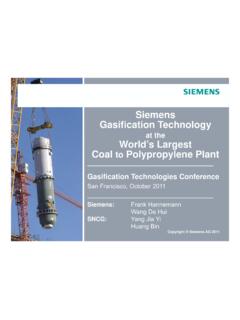Transcription of INTEGRATED RESOURCE PLAN UPDATE - Department of …
1 INTEGRATED RESOURCE plan UPDATE ASSUMPTIONS, BASE CASE RESULTS AND OBSERVATIONS REVISION 1 November 2016 This IRP UPDATE documentation has been released for consultation purposes only. Final IRP UPDATE will be published once the consultation process and policy adjustment has been concluded. i Purpose of the Report The INTEGRATED RESOURCE plan (IRP) 2010-30 was promulgated in March 2011. It was indicated at the time that the IRP should be a living plan which would continue to be revised by the Department of Energy (DoE). This report highlights the process, progress and observations from the IRP UPDATE Base Case (the starting point) as well list the scenarios to be analysed before the IRP is finalised.
2 The sections of the report therefore cover: The IRP UPDATE Process Assumptions Results and observations from the base case List of scenarios that are being considered ii Contents 1. IRP UPDATE Process .. 6 2. Planning Assumptions and Input Parameters .. 8 Expected Demand ..9 Economic parameters .. 10 Eskom Plant Performance .. 11 Committed Eskom New Build Dates .. 12 Non-Eskom plant .. 12 Ministerial Determinations .. 13 Anticipated INTEGRATED Demand Management .. 13 Eskom Plant Life and Air Quality Retrofit .. 14 3. New Generation Technology Cost and Performance Characteristics .. 16 Conventional Power Plants .. 16 Renewables Power Plants .. 18 Energy Storages .. 20 Learning Rates .. 21 4. Emission constraints and costs .. 22 CO2 Emission Constraints.
3 22 Externalities Costs .. 23 5. Results and Observations from the IRP UPDATE Base Case .. 24 6. IRP UPDATE Scenarios .. 27 iii Figures Figure 1: IRP UPDATE Process .. 7 Figure 2: Energy Demand Forecast .. 9 Figure 3: Eskom Fleet Plant Performance .. 11 Figure 4: Profile of Residential Mass Rollout DSM .. 14 Figure 5: Conventional Power Plants screening curves .. 17 Figure 6: Renewable Energy Technologies Screening 19 Figure 7: Storage options screening curves .. 20 Figure 8: Energy Storage options .. 21 Figure 9: Emission Constraints .. 22 Figure 10: Technology Percentage share by Installed Capacity (MW) .. 24 Figure 11: Technology Energy Production Percentage share (TWh) .. 25 Tables Table 1: IRP UPDATE Progress .. 8 Table 2: Economic Parameters .. 10 Table 3: Committed New Build Dates.
4 12 Table 4: Non-Eskom Capacity .. 12 Table 5: MW cumulative capacity from Ministerial Determinations IRP UPDATE base case .. 13 Table 6: Air Quality Retrofits .. 15 Table 8: Option Cost Conventional Power Plants .. 16 Table 9 : Option Cost Renewables Power Plants .. 18 Table 10: Energy Storage .. 20 Table 11: Technology learning Rates .. 21 Table 12: Cost of externalities .. 23 Table 13: IRP UPDATE base case 26 iv List of Abbreviations CCGT Combined-Cycle Gas turbine CoD Commissioning Dates CoGen Cogeneration CSP Concentrated Solar Power DMP Demand Market Participants DEA Department of Environmental Affairs DoE Department of Energy DSM Demand Side Management EAF EUF Energy Availability Factor Energy Utilisation Factor EPRI Electric Power Research Institute FOR Forced Outage Rate GDP Gross Domestic Product GJ Giga Joule ICE Internal Combustion Engine IPP Independent Power Producer IRP INTEGRATED RESOURCE plan LNG Liquefied Natural Gas MTSAO Medium Term System Adequacy Outlook NERSA OCGT National Energy Regulator of South Africa Open Cycle Gas Turbine POR Planned Outage Rate PPA Power Purchase Agreement PPI Producer Price Index REBID DOE Renewable Energy Bid Window
5 Programme RFP Request For Proposal kW Kilo Watts MW Mega Watts GW Giga Watts kWh Kilo Watt hour TWh Tera Watt hour v Glossary Discount Rate: The discount rate is a critical factor influencing any analysis of economic effects over time. Discount rates effectively express a time preference for money money right now is preferred to money in the future. Exchange Rate: Quantifies the amount of Rands required to get one dollar. Cost of Unserved Energy: The COUE is the value (in Rands per kWh) that is placed on a unit of energy not supplied due to an unplanned outage of short duration. Overnight Capital Cost: Describe the cost of building a power plant overnight and is expressed in R/kW Lead Time: Describe the number of years required to bring the plant to full commercial operation.
6 Fixed O&M Cost: Describes the amount of fixed operation and maintenance per year that the power will incur regardless of the station s output in R/KW per year. Variable O&M Cost: Describes the amount of variable operation and maintenance that the Planned Outage Rate: This parameter describes the amount of time during which the plant is down on planned maintenance and is expressed as a percentage Unplanned Outage Rate: This parameter describes the amount of time during which the plant is down on unplanned maintenance and is expressed as a percentage Heat Rate: This parameter describes the amount of fuel energy required to produce one MW and is expressed in GJ/MWh Fuel Price: Describe the price of fuel in R/GJ. Energy Content: Describes the amount of energy content per tonne of fuel supplied and is expressed in GJ/tonne Price Elasticity of Demand: This parameter describes how energy demand changes per unit increase in electricity price and is expressed as a ratio.
7 Reserve Margins: This parameter measures how much the installed capacity is exceeding/falls short of meeting peak demand P50 and P80: Refers to 50% and 80% probability of materialising respectively 6 1. IRP UPDATE Process The IRP 2010-30 identified the preferred generation technology required to meet expected demand growth up to 2030. The policy adjusted IRP incorporated a number of government objectives, including affordable electricity, carbon mitigation, reduced water consumption, localisation and regional development, producing a balanced strategy toward diversified electricity generation sources and gradual decarbonisation of the electricity sector in South Africa. There has been some progress over the past three years, since the promulgation of the IRP 2010-30, in executing the programmes identified in the plan .
8 A number of Ministerial Determinations have been issued and these include, renewable energy, nuclear, coal and gas. While the IRP 2010-30 remains the official government plan for new generation capacity until it is replaced by an updated plan , there are a number of assumptions that have changed and they include: The changed electricity landscape over the past three years, in particular in electricity demand and the underlying relationship with economic growth; New developments in technology and fuel options (locally and globally); Scenarios for carbon mitigation strategies and the impact on electricity supply up to 2050; and The affordability of electricity and its impact on demand and supply. The IRP UPDATE process is as depicted in Source: DOE Figure 1 below takes the following approach: 1.
9 Collating the latest Assumptions from the various sources; 7 2. Developing a credible Base Case from the IRP 2010 by updating the underlying assumptions based on new information; 3. Considering different scenarios or test cases based on alternative government policies or strategies and differences in future economic and RESOURCE terrains. Information from these scenarios will be used to inform the policy adjustment phase of the IRP; and 4. The development of a proposed path of least regret, incorporating the benefits of flexibility by developing decision trees to indicate decisions needed before the next UPDATE . Source: DOE Figure 1: IRP UPDATE Process 8 The current IRP UPDATE process progress is as follows: Table 1: IRP UPDATE Progress Activity Status Comments Assumptions Done This is subject to comments from various stakeholders.
10 Base Case Done This is subject to change based on to be comments received on the assumptions. Scenarios In Progress The results of the scenarios will also be impacted by changes to the assumptions. Number of scenarios may also change based on feedback from public consultations. Policy Adjusted IRP To follow after scenarios This will follow once the scenarios and public consultation is completed Source: DoE 2. Planning Assumptions and Input Parameters Key assumptions that have changed, from the promulgated IRP 2010-30, include amongst others, technology costs, electricity demand projection, fuel costs and Eskom existing fleet performance. The costs for generic technologies used in the IRP 2010-30 were based on the July 2010 report by the Electric Power Research Institute (EPRI).
